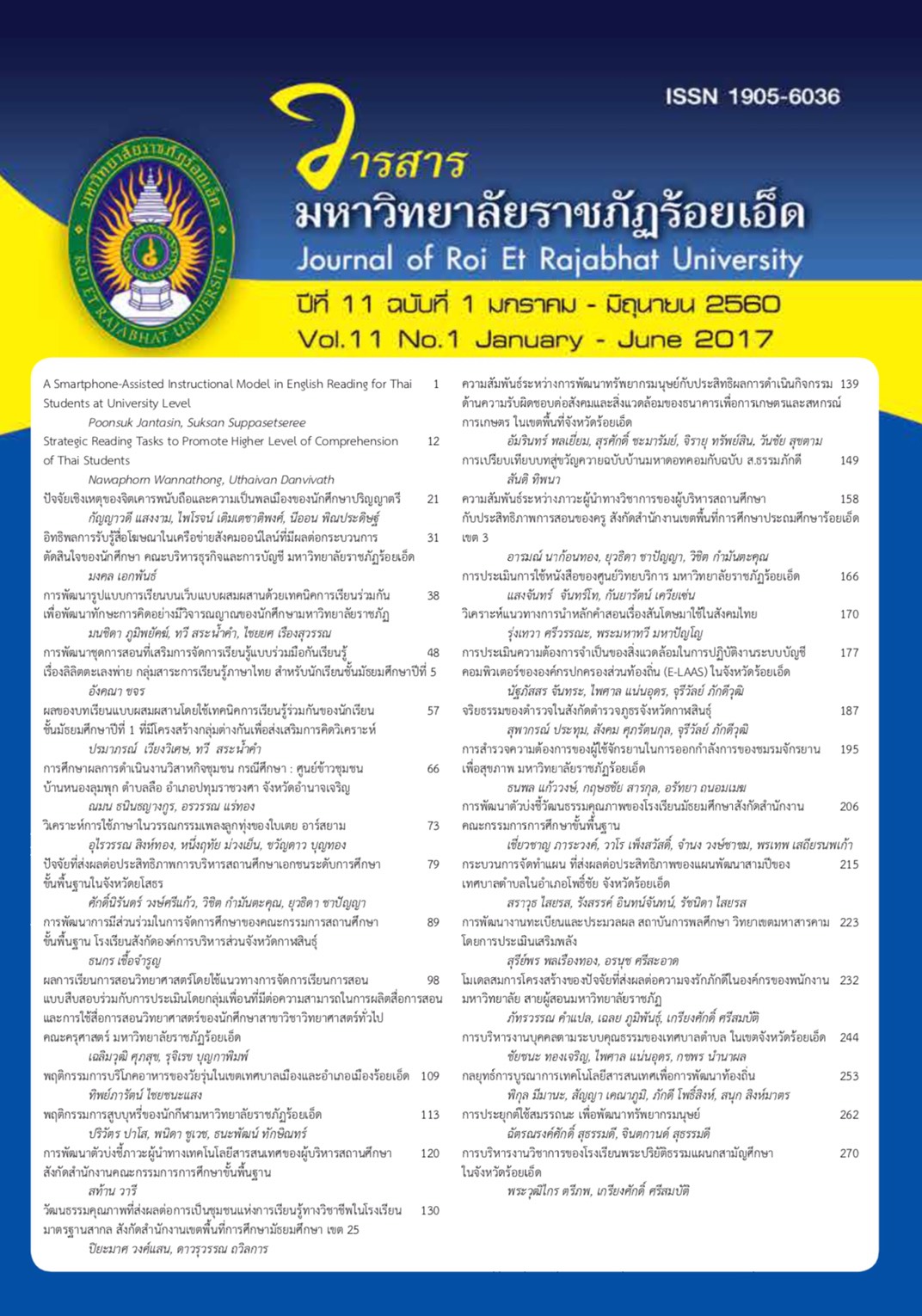Application of Competencies for Human Resources Development
Keywords:
Competency, Human Resource DevelopmentAbstract
"Human" is seen as a valuable asset management in most organizations on the assumption that humans can add value to the organization through the recruitment, selection, development and human performance. Therefore, there are various more complex formats of development of human resources. The competency–based human resource development can be carried out through the following activities : 1) the recruitment and selection. 2) Preparation of
training routes. 3) Appraising performance 4) Preparation of a career path. 5) Individualized development 6) Migration 7) Dismissal and promotion. Therefore, classification and knowledge of the individually specified competencies for each position will assist organizational development easily and affordably. The competency–based human resource management model can incorporate the principles of quality management cycle well known as PDCA, applying
them into the planning of human resources, which must take into account the concept of performance (Competency) of each person, including the ability to track and evaluate the work, based on the concept of performance
(Competency). The result of the undertaking is brought about to improve the functioning of the organization toward further success.
References
ขจรศักดิ์ ศิริมัย. (2555). [ออนไลน์]. แนวทางการพัฒนาระบบสมรรถนะเพื่อพัฒนาการบริหารทรัพยากรบุคคล
มหาวิทยาลัยเทคโนโลยีราชมงคลพระนคร. [สืบค้นเมื่อวันที่ 15 ตุลาคม 2555]. จาก
http://competency.rmutp.ac.th
เจริญวิทย์ สมพงษ์ธรรม. (2553). การพัฒนาสมรรถนะการปฏิบัติงาน สมรรถนะหลัก. ชลบุรี : มหาวิทยาลัยบูรพา
ณรงค์วิทย์ แสนทอง. (2547). มารู้จัก COMPETENCY กันเถอะ. กรุงเทพฯ : เอช อาร์ เซ็นเตอร์.
วรากรณ์ สามโกเศศ. (2542). โลกนี้ไม่มีอะไรฟรี. กรุงเทพฯ : มติชน.
ศิริวรรณ เสรีรัตน์ และคณะ. (2545). องค์การและการจัดการ. กรุงเทพฯ : ธรรมสาร.
สานักงานคณะกรรมการข้าราชการพลเรือน. (2547). การปรับใช้สมรรถนะในการบริหารทรัพยากรมนุษย์. เอกสาร
ประกอบการสัมมนา เรื่อง สมรรถนะของข้าราชการ. กรุงเทพฯ : สานักงานข้าราชการพลเรือน.
สีมา สีมานันท์. (2553). การพัฒนาสมรรถนะองค์การ. มติชน. 23 พฤศจิกายน 2553.
สุกัญญา รัศมีธรรมโชติ. (2548). แนวทางการพัฒนาศักยภาพมนุษย์ด้วย COMPETENCYBASEDLEARNING.
พิมพ์ครั้งที่ 2. กรุงเทพฯ : ศิริวัฒนาอินเตอร์พริ้น.
อานนท์ ศักดิ์วรวิชญ์. (2547). แนวคิดเรื่องสมรรถนะ Competency: เรื่องเก่าที่เรายังหลทาง. Chulalongkorn
Review. 16 (ก.ค. – ก.ย.) : 57 – 72.
อาภรณ์ ภู่วิทยพันธ์. (2548). Competency dictionary. กรุงเทพฯ : เอช อาร์ เซ็นเตอร์.
อเนกลาภ สุทธินันท์. (2548). แนวทางการนาสมรรถนะทั้ง 5 ไปเพิ่ม ประสิทธิภาพ การปฏิบัติงานอย่างได้ผล.
กรุงเทพฯ : อัดสาเนา.
McClelland, David C. (1999). (Online). “Identifying Competencies with Behavioral-event
interviews”. Psychological Science, 9(5). [Retrieved December 11, 2005].
fromwww.eiconsortium.org/research/business_case_for_ei.htm.
Parry, Scott B. (1997). Evaluating the Impact of Training. Alexandria, Virginia : American Society for
Training and Development.
Spencer, LM. and Spencer, SM. (1993). (Online). Competence at Work : Models for Superior
Performance. Retrieved December 11, 2005. from www.joe.org/joe/1999december/iw4.html
Spencer, LM. and Spencer, SM. (1993). (Online). Competence at Work : Models for Superior
Performance. Retrieved December 11, 2005. from
Downloads
Published
How to Cite
Issue
Section
License
บทความที่ได้รับการตีพิมพ์เป็นลิขสิทธิ์ของวารสารมหาวิทยาลัยราชภัฎร้อยเอ็ด
ข้อความที่ปรากฏในบทความแต่ละเรื่องในวารสารวิชาการเล่มนี้เป็นความคิดเห็นส่วนตัวของผู้เขียนแต่ละท่านไม่เกี่ยวข้องกับมหาวิทยาลัยราชภัฎร้อยเอ็ด และคณาจารย์ท่านอื่นๆในมหาวิทยาลัยฯ แต่อย่างใด ความรับผิดชอบองค์ประกอบทั้งหมดของบทความแต่ละเรื่องเป็นของผู้เขียนแต่ละท่าน หากมีความผิดพลาดใดๆ ผู้เขียนแต่ละท่านจะรับผิดชอบบทความของตนเองแต่ผู้เดียว





